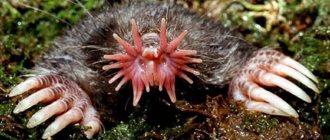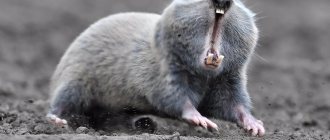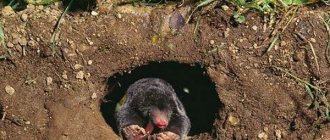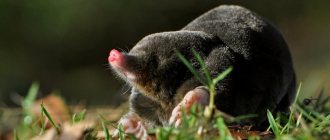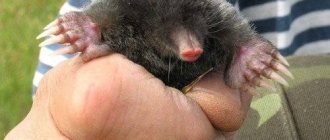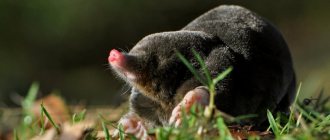Name: Common, South Russian and small-eyed mole rat Lat.:
Spalax microphthalmusClass: Mammals - Mammalia Order: Rodents - Rodentia Family: Mole rats - Spalacidae
| Habitats: | garden |
| Dangerous for: | roots, bulbs and rhizomes |
| Description: | A year-round active animal with a big appetite. |
Description and photo of the animal mole rat
Mole rat.
Mole rats are small animals of the rodent order. Their lifestyle is similar to moles, but outwardly they have significant differences.
Appearance of the animal
Adults can weigh up to 700 grams or more. The animal's body reaches 20-32 cm in length and has an oblong, cylindrical shape. The fur is thick, short, and colored pale gray-brown.
The neck is poorly defined. The legs are very short. The tail is not developed and is hidden under the skin. The head is the widest part of the animal's body and has a flattened shape. The animal has no ears, and its eyes are hidden under the skin. The incisors are pronounced and grow on top of the lips.
Have you seen a mole rat?
Not really
Lifestyle of mole rats
Mole rats on the surface of the earth are a rare occurrence.
The animals spend almost their entire lives underground. The burrow system of this animal is very well branched and has two tiers. The so-called “feeding passage” is the longest and is located at a depth of 20-25 cm. The mole rat’s home is equipped with summer and winter nests, as well as storage facilities for food supplies.
Unlike moles, mole rats make their way with the help of incisors. From the soil that the animal pushes out, characteristic mounds are formed - “mole rats”. The diameter of such “mole rats” can reach 50 cm. The total length of moves made by one rodent can be up to 450 m.
Mole rats do not hibernate in winter and therefore store large reserves of food. Winter supplies of one such rodent can weigh up to 14 kg.
What does the animal eat?
The diet of mole rats consists mainly of plant foods. The animal feeds on bulbs, tubers and rhizomes of various plants. Sometimes a rodent can feast on young stems and leaves, which it drags underground by grasping the rhizome.
Among the animal's winter supplies you can find acorns, onions, potatoes and beets.
Reproduction
An enemy in a fur coat.
Mole rats usually live in groups of 2-3 individuals, including one male and 1-2 females. If there is more than one female in a family, then they take turns producing offspring.
Cubs are born in the spring. Around this time, the male leaves the female who gave birth and goes to the one who will bear offspring next year.
One litter produces 2-3 cubs. Young females begin to move away from their mother already in the first year after birth. They settle mainly closer to the surface, so they often die before reaching two years of age. The mortality rate among young males is much lower, because they move away from their mother only in the second year and settle underground.
The average lifespan of mole rats in the wild is 2.5-4 years. Some specimens can live up to 9 years.
Litmus test
The common shrew is considered a pest because it eats the eggs of commercial fish. But when it began to disappear en masse in many areas of its former range, it was immediately forgotten. Just as biologists use mice to understand the level of pollution in forests and fields, so the shrew serves as a litmus test for the ecology of water bodies.
Anna Zvyagintseva, a resident of the Krasnogvardeisky district, described her uncle’s meeting with this animal:
“When he was sitting on the ice with a fishing rod, the cutter itself ran up to him and hid under his boot. He started filming it on his phone to show it to me. How interesting it was to watch her! She dived into a hole made for fishing and swam in the snow. And then the second one appeared. What they did together is beyond words! It turns out that the shrew, listed in the Red Book, lives on our Userdets River.”
After reading online sources, I learned that the Russian muskrat and the common shrew settle in oxbow lakes, small quiet backwaters, but always in ecologically clean rivers with forests along the banks. This means that the Userdets River is an environmentally friendly reservoir.”
Mole rat habitat
The habitat of mole rats includes steppe, forest-steppe, semi-deserts and deserts. Most often the animal is found in steppe and flat areas. Since mole rats feed mainly on plant foods, they happily settle in grassy meadows and clearings. In rare cases, mole rats can be found on the outskirts of forests.
When choosing soil, rodents prefer moderate density.
In clay and sandy soils, the mole rat most likely will not stay long.
The animals also do not particularly like salt marshes and wet areas.
Is the mole rat the same mole?
No, this is a wrong opinion. Animals are different, although they have a similar lifestyle.
Do mole rats bite?
Yes, and very much so. But he does not attack himself, but only in case of self-defense. His vision is not developed at all and in case of danger he attacks everyone and everything, relying only on hearing.
How likely is it to meet him?
Although the population is quite large, it is unlikely to encounter a mole rat. If it accidentally hits the surface, it freezes, listening and orienting itself, then backs away to get into its hole.
Mole nutrition
Moles are insectivores; the basis of their diet are earthworms. They collect them in feeding passages, and the worms themselves crawl into these holes, attracted by the smell secreted by the mole.
The mole is a mammal that leads a 24-hour, year-round lifestyle. It feeds 3-4 times a day, eating about 20-30 grams of worms.
After feeding, the mole moves to the nesting hole and, curled up in a ball, goes to sleep for 3-5 hours, after which it again begins to search for food.
If an animal finds more worms than it can eat, the mole takes them to special storage places, a kind of storehouse, after first biting off their heads, and returns to eating them after waking up.
How to deal with a pest
The mole rat is a rodent whose habits are very similar to the mole. They are often even confused due to similar dietary preferences. The fight against mole rats is carried out using the same methods as with moles. For more information about them, follow the links below to the portal articles.
Plants are a safe way to protect your area from moles and other rodents.
Mole traps allow you to catch the pest quickly and easily.
The greenhouse requires protection from moles; they are comfortable there at any time.
Proven methods of controlling moles on the site. Fast and efficient.
What do moles and shrews eat?
In addition to worms in the diet of moles
includes mole crickets, chafer larvae, caterpillars, and various small insects.
Sometimes they come across larger prey - mice, sick and weakened rats, lizards, small snakes and other snakes, frogs, shrews
.
Interesting materials:
How to connect your phone to TV using Wi-Fi? How to connect your phone to TV using wifi? How to connect your phone to a Samsung 7 series TV? How to connect your phone to a Samsung TV wirelessly? How to connect your phone to a Samsung TV without a smart TV? How to connect your phone to a Samsung TV via Wi-Fi? How to connect your phone to a Samsung TV? How to connect your phone to a Sharp TV? How to connect your phone to Skyward TV? How to connect your phone to a Smart TV?
Places where moles live
Moles like to inhabit the following places:
- meadows;
- forest clearings;
- birch forests and copses;
- areas near roads;
- parks within the city;
- garden and vegetable plots.
Molehills are often found where the soil is enriched with humus, populated by worms, arthropod larvae, and heated by the sun. Soil moisture is also of great importance; it should have average values.
Traces of moles are unlikely to be found in the following places:
- dense forest;
- Pinery;
- swampy places;
- places where plants with strong roots grow.
The mole’s choice of place to live also depends on the annual amount of precipitation and soil temperature. If the climate in the area is not stable, moles move closer to the forest, where the depth of soil freezing in winter is less, and in summer moisture in the soil is better retained.
The mole will constantly change its location until it finds comfortable living conditions for itself.
Animal species
In total, about 40 species of moles are known. Some of them are quite common, others are very rare. They differ in appearance, habitat and behavioral characteristics. Main types:
- European or ordinary;
- Japanese shrew;
- American;
- Siberian;
- Caucasian;
- Ussuri mogera;
- star-nosed
The first species of animal is found in Europe, which is why it received its name. The common mole grows small: body length - 16 cm, weight - no more than 100 g. The Japanese shrew mammal is even smaller, and it is found on the islands of Shikoku, Tsushima, Honshu and Dogo. On the mole's muzzle there is a long proboscis with hairs that capture air vibrations. In search of food, the shrew can climb bushes and trees.
The American mole lives in Canada and the USA. These are black and gray animals with thick fur. The length of their tail sometimes exceeds the size of their body. The animal swims well and can climb trees. The description of such a mammal is similar to the Japanese shrew; biologists consider them to be related species.
The Siberian or Altai mole resembles the European one. But females are very different from males. The round body of males reaches 20 cm in length, they weigh only 150 g, and females grow smaller. Males are usually black or brown, females are gray. This species has no ears at all, but the nose has turned into an elongated proboscis.
The Caucasian mole's eyes are covered with a film. But it has a more subtle sense of smell than other species. The black, silky coat fades with age. The mole, which is called the Ussuri mogera, looks very interesting. This is a large animal compared to its other relatives: body length - 21 cm, body weight - up to 300 g. This mole has underdeveloped eyes, and it is a rare species, therefore measures have been taken to protect it in the Far East, Korea and China.
The North American star-nosed bat or star-nosed fish is so named because of its unusual nose. This part of the body consists of many tentacles, each of them has olfactory receptors. The animal loves water very much and often lives near bodies of water. He swims well and can dive.
Keeping moles at home.
Keeping moles at home is not recommended. This is a troublesome task. Preparing a place for them to live is quite difficult. In a small box, the soil quickly becomes dirty and damp. Animals in such conditions are susceptible to disease. If you replace the soil with other fillers, the moles will be deprived of physical activity, not performing the usual excavation work, and will die from obesity. Feeding a mole in captivity is quite difficult. In addition, animals are very sensitive to various sounds and vibrations, which cause them stress.
Appearance description
The behavior and appearance of the mole have not been studied in as much detail as we would like. The fact is that the mammal chooses hard-to-reach places to live. But still, biologists were able to track this animal in the wild.
It is in appearance that the relative nature of the mole’s adaptability to life underground is revealed. The animal has strong front legs, which allow it to constantly dig the ground. The rounded hands resemble oars in appearance, and the wide palms are turned outward. The fingers are spread apart and end in long, strong claws.
The hind legs are not so strong; with them the mole only scrapes loose soil out of the hole. A long muzzle with an elongated nose helps the animal find food and safe places by smell. The body is covered with a short fur coat, which does not interfere with movement through narrow underground passages.
The wool grows upward and can bend in any direction. The common mole is black-brown or dark gray in color. The mammal has eyes, but they only distinguish between light and darkness. The animals are practically blind, although they do not need vision underground. The structure of the eyeball of moles differs from the organs of other animals . They do not have a lens or retina . Movable eyelids and thick fur protect the eyes from soil getting into them. Mammals have a well-developed sense of smell.
Reproduction and lifespan
Moles are solitary animals; they pair up only during the breeding season to procreate. By the age of one year, moles reach sexual maturity.
The breeding season occurs once a year in early spring. The female prepares the nest alone for the brood; the male does not participate in this.
Forty days after conception, small, completely hairless cubs are born. There are usually about five of them in a litter, less often it reaches 8-9 individuals.
In the photo there are baby moles
For a month, the offspring stay with the female, who brings them food and cares for her children. Subsequently, the young leave the female’s burrow and begin to build their own home. If the young brood does not leave the nest, then the female may even bite it, thereby driving it into independent adulthood.
